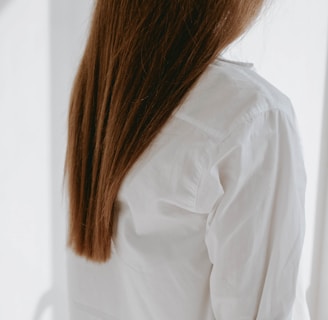WHAT IS NANO PLASTIA HAIR TREATMENT: THE ULTIMATE GUIDE
EVERYTHING YOU NEED TO KNOW BEFORE UNDERGOING THE NEW HAIR TREATMENT THAT BEATS KERATIN AND BOTOX TREATMENTS! While nano plastia treatments aim to nourish and repair the hair, there is potential risk
BEAUTY
9/25/20235 min read


WHAT IS NANO PLASTIA HAIR TREATMENT?
It is a hair straightening and smoothing treatment that aims to reduce frizz, restore shine, and improve manageability of the hair. The treatment uses a combination of nanotechnology and keratin to penetrate the hair cuticles and repair any damage. It is often considered a less aggressive alternative to traditional keratin treatments, as it does not contain formaldehyde. Nano plastia hair treatment typically lasts for a few months and is suitable for most hair types.
WHAT IS THE PROCEDURE OF NANO PLASTIA HAIR TREATMENT?
The procedure for nano plastia hair treatment is as follows:
1. Hair Assessment: A professional stylist will assess your hair type, texture, and condition to determine the best approach for the treatment and desired results.
2. Hair Preparation: Before beginning the treatment, your hair will be washed with a clarifying shampoo to remove any buildup and open up the hair cuticles to allow the product to penetrate effectively.
3. Application: The nano plastia treatment solution will be applied to your damp hair using a brush or applicator. The solution is usually applied section by section, ensuring even coverage from root to tip.
4. Processing Time: Once the solution is applied, it needs to be left on the hair for a specific amount of time, typically 30 to 60 minutes. The processing time may vary depending on your hair type and desired results.
5. Heat Application: After the processing time, heat is applied to the hair using a blow dryer and a flat iron. The heat helps to seal the treatment solution into the hair cuticles, providing long-lasting results.
6. Rinse and Blowout: Once the heat application is complete, your hair will be rinsed with water to remove any excess product. It will then be blow-dried and styled as desired.
7. Post-Treatment Care: After the nano plastia hair treatment, it is important to follow any specific care instructions provided by your stylist. This may include avoiding washing your hair for a specific period of time and using sulfate-free shampoos and conditioners to maintain the results.
It's worth noting that the exact procedure may vary slightly depending on the brand of the nano plastia treatment or the stylist's preference.
WHAT ARE THE PRODUCTS USED FOR NANO PLASTIA HAIR TREATMENT?
Nano plastia hair treatment typically involves the use of specific products formulated for the treatment. The exact products used may vary depending on the brand or salon, but here are some common products used in nano plastia hair treatments:
1. Nano Plastia Treatment Solution: This is the main product used in the treatment. It contains a combination of ingredients, such as amino acids, proteins, keratin, and other nutrients, that help to smooth, hydrate, and repair the hair.
2. Clarifying Shampoo: A clarifying shampoo is used in the pre-treatment phase to remove any buildup or residues from the hair, ensuring that the nano plastia treatment can penetrate effectively.
3. Sulfate-Free Shampoo and Conditioner: After the treatment, it is recommended to use sulfate-free shampoos and conditioners to maintain the results and prolong the effects of the treatment.
4. Heat Protectant: A heat protectant spray or serum is used before applying heat during the treatment process. It helps to protect the hair from heat damage caused by blow drying and flat ironing.
5. Blow Dryer and Flat Iron: These are essential tools used during the treatment process to dry and seal the nano plastia treatment solution into the hair cuticles.
ADVANTAGES
Nano plastia hair treatment offers several advantages:
1. Smoothing and straightening:
The treatment helps to smooth and straighten frizzy, curly, or unruly hair, reducing frizz and promoting a sleek, polished look. It can significantly improve the manageability and texture of the hair, making it easier to style.
2. Hair repair and hydration:
Nano plastia treatments infuse the hair with nourishing ingredients like amino acids, proteins, and keratin, which help to repair damage and restore moisture to the hair. This can improve the overall health and condition of the hair, making it look and feel healthier and more vibrant.
3. Long-lasting results:
Unlike some other hair treatments that may only provide temporary results, nano plastia treatments can offer long-lasting effects. The treatment helps to create a protective shield around the hair cuticles, sealing in the nutrients and moisture and prolonging the results.
4. Reduce styling time:
With smoother and more manageable hair, you may find that your styling time is significantly reduced. The hair becomes easier to detangle, blow-dry, and style, saving you time and effort in your daily hair routine.
5. Versatility:
Nano plastia treatments are suitable for various hair types, including damaged, chemically treated, and colored hair. It can be used to straighten, soften, and improve the condition of the hair, regardless of its texture or thickness.
It's important to note that individual results may vary, and the longevity of the treatment depends on factors like hair type, aftercare, and maintenance routine.
DISADVANTAGES
While nano plastia hair treatments offer several advantages, there are also some potential disadvantages to consider:
1. Cost:
Nano plastia treatments can be relatively expensive compared to regular hair treatments or home remedies. The cost may vary depending on the salon, location, and the length and thickness of your hair. Additionally, multiple sessions or touch-ups may be required to maintain the results, adding to the overall cost.
2. Time-consuming:
The treatment process can be time-consuming as it typically involves several steps, including washing, application of the treatment product, blow-drying, and ironing the hair. The duration of the treatment can vary depending on the length and thickness of your hair.
3. Chemical components:
Nano plastia treatments often contain chemical ingredients, such as formaldehyde or other smoothing agents, which help to achieve the desired results. Some people may have sensitivities or allergies to these chemicals, so it is important to check the product ingredients and consult with a professional stylist before undergoing the treatment.
4. Temporary damage:
While nano plastia treatments aim to nourish and repair the hair, there is a potential risk of temporary damage or hair texture alteration. In some cases, the hair may become overly straight or lose its natural texture, which may not be desirable for everyone.
5. Maintenance requirements:
To maintain the results of the treatment, specific aftercare and maintenance routines may be necessary. This may include using sulfate-free shampoos and conditioners, avoiding heat styling tools, and getting regular touch-up treatments. Failing to follow these guidelines can result in the premature fading of the treatment and reduced longevity of the results.
CONCLUSION
Nano plastia hair treatments have their advantages and disadvantages. They offer benefits such as smoothing and straightening the hair, reducing frizz, and improving manageability. However, they can be costly, time-consuming, and may contain chemical ingredients that some individuals may have sensitivities to. Additionally, there is a risk of temporary damage or alteration to the hair texture, and the maintenance requirements can be demanding. Before deciding to undergo a nano plastia treatment, it is important to consider these factors and consult with a professional stylist to make an informed decision that aligns with your hair needs and preferences.
